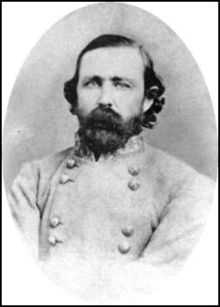George Maney
| George Maney | |
|---|---|
 George Maney | |
| Born |
August 24, 1826 Franklin, Tennessee |
| Died |
February 9, 1901 (aged 74) Washington, D.C. |
| Place of burial | Mount Olivet Cemetery, Nashville, Tennessee |
| Allegiance |
|
| Service/branch |
|
| Years of service | 1846–48, 1861–65 |
| Rank | Brigadier general |
| Commands held |
Mexican-American War
|
| Battles/wars | |
| Other work | Railroad executive, political adviser, U.S. Minister to Colombia, U.S. Minister Resident/Consul General to Bolivia, U.S. Ambassador to Uruguay and Paraguay. |
George Earl Maney (August 24, 1826 – February 9, 1901) was an American soldier, politician, railroad executive and diplomat. He was a general in the Confederate States Army during the American Civil War and a postbellum U.S. ambassador to Colombia, Bolivia, Uruguay, and Paraguay.
Early life and education
George Maney was born in Franklin, Tennessee, to Judge Thomas Maney and his wife. His father was a prominent newspaper editor and circuit judge. Young Maney attended the Nashville Seminary before graduating from the University of Nashville in 1845 at the age of 19.
Military and law
Maney enlisted as a second lieutenant in the 1st Tennessee Regiment during the Mexican-American War (1846–1848). When his three-months term of enlistment expired, he enrolled in the United States Army and served as a first lieutenant in the 3rd U.S. Dragoons, which participated in General Winfield Scott's march to Mexico City.[1]
When hostilities ceased, Maney returned home. He studied law, passed his bar exam in 1850, and established a law practice in Franklin. It became quite successful. Maney subsequently entered politics and was elected to the Tennessee State Legislature.[2]
Marriage and family
Maney married Elizabeth T. "Betty" Crutcher of Nashville in 1853; they raised a family of five children.
Civil War
Following the secession of Tennessee and the beginning of the American Civil War, Maney enlisted in the Confederate army as a captain in the 11th Tennessee Volunteer Infantry. On May 6, 1861, he was promoted to colonel of the 1st Tennessee. He served in western Virginia, first under Robert E. Lee at the Battle of Cheat Mountain and later under Thomas J. "Stonewall" Jackson at Bath and Romney.[3]
Maney asked for a reassignment to his native Tennessee, which was threatened by Union forces. As an officer in the Army of Tennessee, Maney participated in the Battle of Shiloh and was promoted on April 16, 1862, to brigadier general. He led his brigade in the battles of Perryville, Chickamauga, and Murfreesboro. In November 1863, he was wounded severely in his arm during the Chattanooga Campaign. He was on medical leave for much of the rest of the year.
In 1864, Maney commanded a division in William J. Hardee's corps during the Atlanta Campaign. He was captured in August and later released, but he did not return to active field duty because of problems with his wounded arm. Hardee recommended that Maney be promoted to major general, but the request was not fulfilled. Maney surrendered following the Carolinas Campaign and was paroled on May 1, 1865, at Greensboro, North Carolina.
Postbellum career
After the war, Maney returned to his Tennessee home. He became president of the Tennessee and Pacific Railroad in 1868, serving in that executive post for nine years. Unlike many of his former Confederate compatriots, he became an active Republican. He was elected to the state senate. During the carpetbagger era, Maney held considerable influence over the Governor of Tennessee, Dewitt Clinton Senter. Maney helped restore the government to former Confederates once their civil rights were restored.
Maney became active in a number of reconciliation efforts during Reconstruction, working to improve relations between the former enemies. In early 1876, he was a candidate for governor, but withdrew his name from the ballot. In December of that year, his daughter Frances married a former Union officer in the 15th Massachusetts.
During the presidential administrations of James A. Garfield, Chester Arthur, and Benjamin Harrison, Maney was appointed as ambassador to various countries in South America. He was the U.S. minister to Colombia (1881–1882), and then was the Minister Resident/Consul General to Bolivia from November 4, 1882, until June 1, 1883. He returned home and was a delegate to the Republican National Conventions of 1884 and 1888. He spent four years (1890–1894) as the U.S. ambassador to Uruguay and Paraguay.
General George Maney died in Washington, D.C., from a cerebral hemorrhage.[4] He is buried in Mount Olivet Cemetery in Nashville, Tennessee.
Notes
References
- Warner, Ezra J., Generals in Gray: Lives of the Confederate Commanders, Baton Rouge: Louisiana State University Press, 1959. ISBN 0-8071-0823-5.
- Warner, Seth, "George Earl Maney: Soldier, Railroader, and Diplomat," Tennessee Historical Quarterly, Vol. LXV (2006), 130-147.
- Welsh, Jack D., Medical Histories of Confederate Generals. Kent, Ohio: Kent State University, 1995. ISBN 0-87338-649-3.
- Winborne, Benjamin Brodie, The Colonial and State Political History of Hereford County, N.C., Murfreesboro, North Carolina: Edwards & Broughton, 1906.
Further reading
- Hewitt, Lawrence L. (edited by William C. Davis), "George Earl Maney," The Confederate General, Vol. 4. Harrisburg, Pennsylvania: 1991.
External links
- Photo gallery of Maney
- American National Biography
- "George Maney". Find a Grave. Retrieved 2009-03-03.
| Diplomatic posts | ||
|---|---|---|
| Preceded by Ernest Dichman |
United States Minister Resident, Colombia September 21, 1881–July 19, 1882 |
Succeeded by William L. Scruggs |
| Preceded by Charles Adams |
United States Minister Resident, Bolivia November 4, 1882–June 1, 1883 |
Succeeded by Richard Gibbs (diplomat) |
| Preceded by John E. Bacon |
United States Minister Resident, Paraguay May 19, 1890–June 30, 1894 |
Succeeded by Granville Stuart |
|